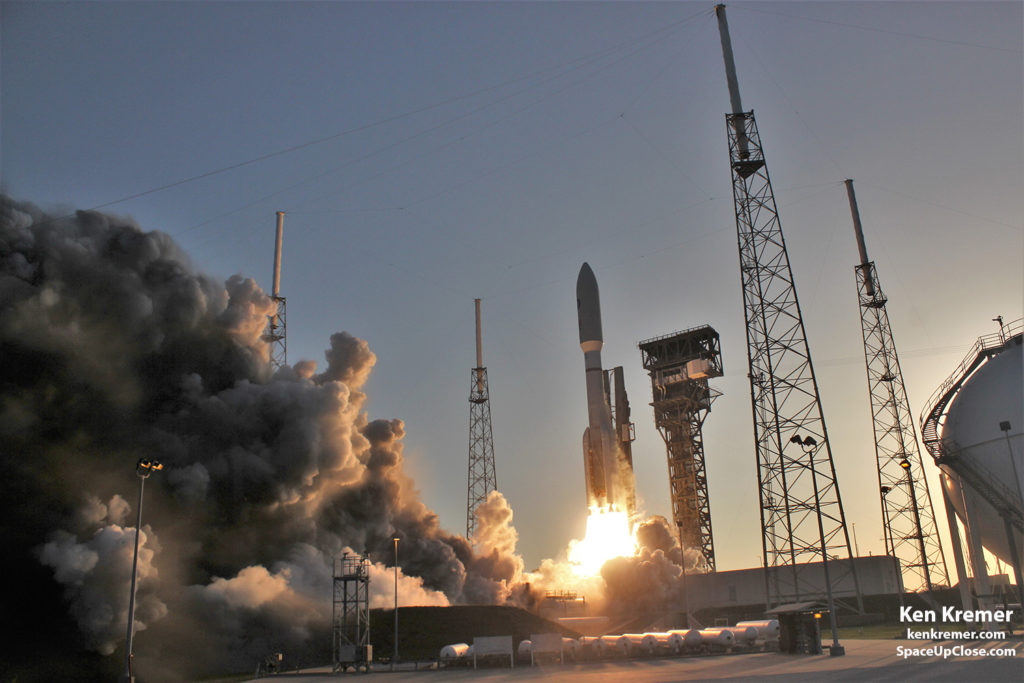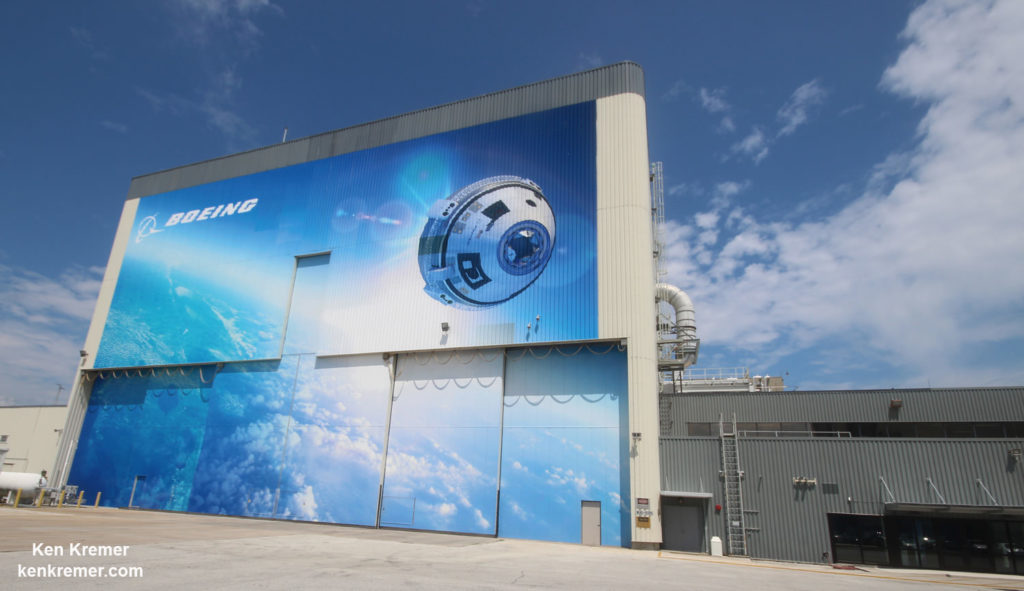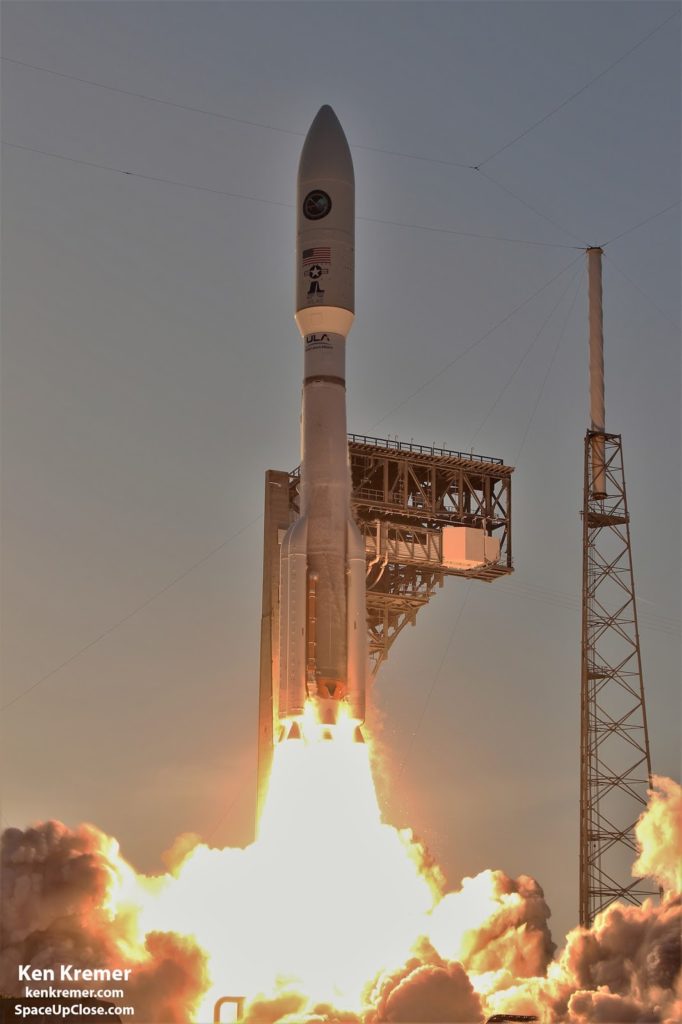 |
|
Artist image of the Boeing Starliner spacecraft docking to the
International Space Station. Image credit: Boeing |
— SpaceUpClose.com — 2 May 2018
NASA and Boeing are studying a significant expansion to the scope of the first crewed
orbital test flight of the Starliner commercial crew spacecraft that would
essentially change its nature from a short duration test flight into a long
duration operational mission while carrying a trio of astronauts to the
International Space Station (ISS).
the test flight were proposed by NASA as “updates to its Commercial Crew Transportation Capability (CCtCap)
contract with Boeing, which provides flexibility in its commercial flight
tests,” NASA said in a statement last month.
for as soon as the end of this year, 2018, Boeing has proposed to NASA that the
inaugural flight of their CST-100 Starliner commercial crew vehicle on the Crew Flight Test (CFT) carry
an additional crew member to up the crew complement from two astronauts to
three.
is also proposing that the mission length be vastly expanded from just two
weeks to up to six months.
Soyuz expedition increments to the ISS.
original plans called for a two person crew comprised of one Boeing test pilot
and one NASA astronaut.
It is widely believed that former NASA astronaut Chris
Ferguson will be tapped as the Boeing test pilot. Veteran astronaut Ferguson served was Commander
of NASA’s last space shuttle mission STS-135 in July 2011.
the contract modification are under evaluation, but the changes could allow for
additional microgravity research, maintenance, and other activities while
Starliner is docked to station,” said NASA.
test could offer NASA an additional opportunity to ensure continued U.S. access
to the orbital laboratory.”
with the SpaceX Crew Dragon, being developed
under the Commercial
Crew Transportation Capability (CCtCap) contract with NASA to
ferry NASA astronauts to and from low Earth orbit and the space station.
September 2014 by NASA Administrator Charles Bolden to complete development and
manufacture of the CST-100 Starliner space taxi under the agency’s Commercial
Crew Transportation Capability (CCtCap) program and NASA’s Launch America
initiative.
Atlas V rocket augmented with two solid rocket boosters from Space Launch
Complex-41 (SLC-41) on Cape Canaveral Air Force Station, FL.
A new crew access tower and arm has also
already been built and installed at pad 41 to support human launches with the
human rated Atlas V.
funding to restore America’s ability to launch American astronauts to space
from American soil on American rockets and thereby end NASA’s 100 percent
reliance on the Russian Soyuz capsule for seats to the ISS.
seats to space have been via the Soyuz currently costing NASA over $82 million
per seat.
under NASA’s Commercial Crew Program (CCP) have suffered repeated delays due to
a combination of funding shortfalls from Congress and technical difficulties in
development and manufacture.
later in 2019, the agency needs alternatives to fly astronauts to space and
ensure access to the ISS.
additional schedule margin if needed,” said William Gerstenmaier, associate
administrator, Human Exploration and Operations Mission Directorate at NASA
Headquarters in Washington, in a statement.
its flight to ensure we have continued access to space for our astronauts.
Commercial space transportation to low-Earth orbit from U.S. soil is critical
for the agency and the nation.”
Orbital Test Flight (OFT) is scheduled for launch in late August and the Crew Flight Test (CFT)
launch is scheduled for November 2018. However those dates could well slip
again since much work remains.
Dragon in August and December 2018 respectively launching on a Falcon 9 from
Launch Complex 39A at the Kennedy Space Center, FL.
Boeing Starliner commercial crew transportation spacecraft is being
manufactured at the company’s Commercial Crew and Cargo Processing Facility
(C3PF) at NASA’s Kennedy Space Center in Florida.
be certified to have completed the daunting and rigorous contracted milestones
before being approved for regular crew rotation missions by NASA.
provide about six months of margin to begin regular, post-certification crew
rotation missions to the International Space Station before NASA’s contracted
flights on Soyuz flights end in fall 2019,” said NASA.
operational mission needs careful review by the technical community,” said
Gerstenmaier. “For example, the spacecraft capability to support the additional
time still needs to be reviewed. Modifying the contract now allows NASA and
Boeing an opportunity to tailor the duration to balance the mission needs with
vehicle and crew capabilities.”
Watch for Ken’s continuing onsite coverage of NASA, Boeing,
SpaceX, ULA, Lockheed Martin, Orbital ATK and more space and mission
reports direct from the Kennedy Space Center and Cape Canaveral Air Force
Station, Florida.
Earth and Planetary science and human spaceflight news: www.kenkremer.com –www.spaceupclose.com –
twitter @ken_kremer – ken
at kenkremer.com





